Things You'll Need
Gloves
Lint-free cloths
Oxygen bleach
Household scouring powder
Toothbrush
Soft-bristle brush
Synthetic dish scouring pad
Tile polish
600-grit wet-dry sandpaper
Two-part tinted epoxy
Porcelain repair kit
Plastic dish
Toothpick
Paintbrush
Baking soda
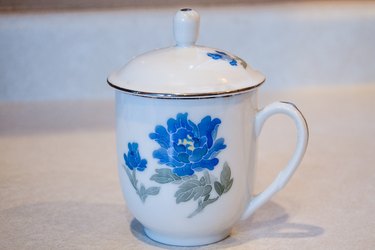
Porcelain and porcelain enamel may have different bases, the former clay and the latter cast iron or stainless steel, but you can repair small scratches on the glass-like glaze or coating in the same way. When the scratch hasn't fully penetrated the outer surface, clean the porcelain before buffing out the scratch. If the base metal or clay is exposed, clean and then replace the missing coating with two-part epoxy or a porcelain repair product.
Clean It Up
Step 1
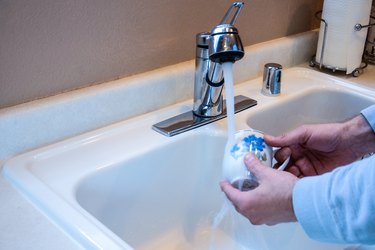
Rinse the porcelain with clean, cool water to remove lose grime and buildup.
Video of the Day
Step 2
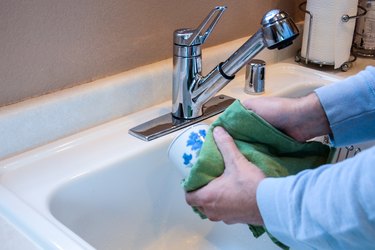
Wipe the surface down with a dry, lint-free cloth. Dilute 1/4 cup of oxygen bleach in 4 cups of warm water. Dip a soft rag into the solution and apply it liberally to the porcelain. Let the solution sit for 15 minutes.
Step 3
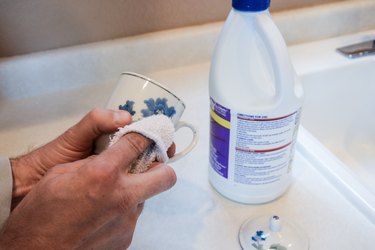
Scrub the surface with a soft rag to work the diluted oxygen bleach into the porcelain and loosen dirt and grime. Rinse the area with clean, cool water.
Buff It Out
Step 1
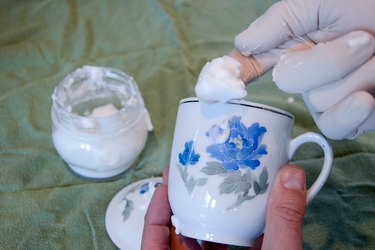
Create a paste with household scouring cleaner and water; the solution should be thick and slightly clumpy, not runny. Wearing gloves, apply an even layer over the scratch. Wait five to 10 minutes.
Step 2

Buff the paste into the porcelain with an old toothbrush, soft bristle scrub brush or a mild synthetic scouring pad meant for dishes. Do not use steel wool or anything similarly abrasive. Work in circular motions until the cleaning tool picks up most of the paste and the scratch disappears.
Step 3

Rinse the area with clean, cool water. Apply tile polish to a soft, lint-free rag and buff it over the freshly removed scratch area to restore shine and blend the area with the surrounding, undamaged porcelain.
Fill It In
Step 1
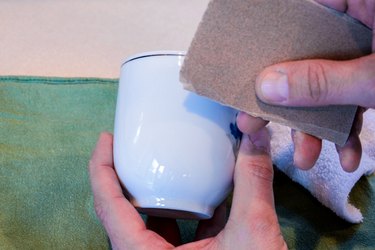
Fold or cut a piece of 600-grit wet-dry sandpaper into a manageable square. Working from the inside of the scratch out, sand the area briefly to create a slightly gritty surface. If you're repairing porcelain enamel, sand off any rust on the exposed metal. Wipe the porcelain down with a wet rag to remove the dust.
Step 2

Mix two-part epoxy, in a shade that matches the porcelain, in a small plastic dish. Porcelain-specific repair kits also work well, and some don't require mixing, only an accurate color match on your part.
Step 3

Dip a wooden toothpick into the epoxy or porcelain repair product. Starting from the center of the scratch, fill in the damage. If the scratch isn't very deep, a thin paintbrush works well.
Step 4

Let the enamel or patch product dry completely, at least 24 hours. After seven to 10 days, gently buff the area with a paste of baking soda and water to gradually blend it with the surrounding area.
Tip
An accurate color match is essential for a seamless repair. Porcelain repair kits come in a variety of colors, but two-part epoxy is more limited, available in white, off-white and gray. Choose a product that gives you the closest color match possible.
For high-heat appliances, including porcelain enamel topped stoves, contact a professional for the most durable refinishing.
Warning
Work in a well-ventilated area and wear gloves during repairs. Oxygen bleach, scouring powder and epoxy products are high in fumes.
Do not use epoxy to repair scratches in porcelain enamel dishes or cookware. To be food safe, these products need to be set with a very high heat after repairs. Contact a professional for help.
Video of the Day
- Chicago Tribune: Ceramic Tile Sealers Guard Against Stains, Not Scratches
- The Family Handyman: How to Fix a Chipped Sink
- Porcelain Enamel Institute: Care and Cleaning
- Arizona State University Herberger Institute for Design and the Arts: Lesson Two -– Part 1: Earthenware, Stoneware, and Porcelain
- Michigan State University Extension: Porcelain Enamel Characterisitcs
- Apartment Therapy: Housekeeping Hints: How to Clean, Fix & Maintain Tile Floors